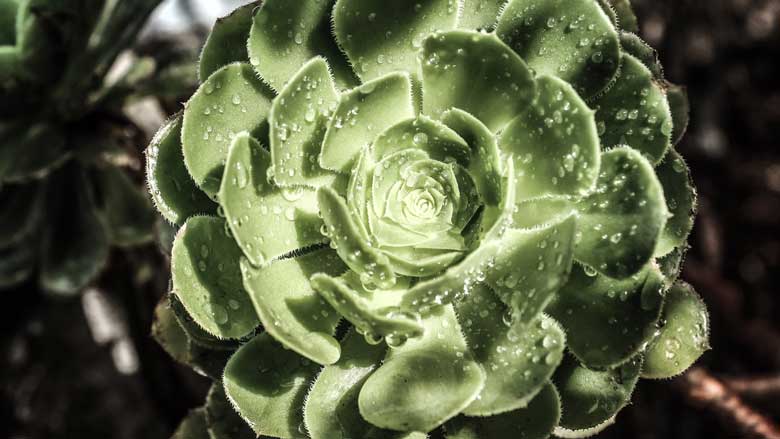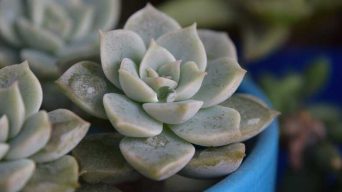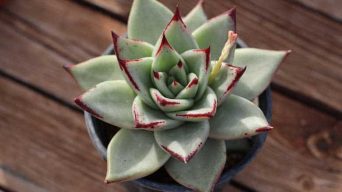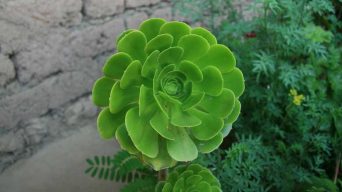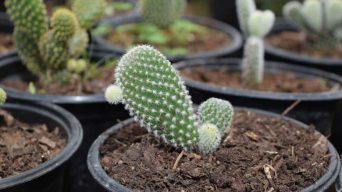If you’re a succulent lover, then you’ve probably asked yourself this question before: what happens to succulents when it rains?
Succulents are tough plants and can usually handle a little bit of rain, but it’s important to know what kind of weather your succulents can withstand.
In some cases, leaving succulents out in the rain can be harmful.
So, is it OK to leave succulents in the rain? Will rain kill my succulents
The answer is not always simple, but we will tell you everything you need to know about succulents and rain in this easy guide.
Is Rainwater Good for Succulents?
Rainwater can benefit succulents as it does not contain any chemicals such as chlorine and fluoride.
Mineral water and tap water, on the other hand, are unsuitable for succulents since they alter the pH of the soil.
Also, during a rain, all of the salts, minerals, and impurities are washed away from the soil.
But can succulents handle rainwater well?
They are succulent plants, after all!
Succulents store water in their leaves so that they can withstand periods of drought.
If succulents are watered with rainwater during a drought, it will help them to survive.
But if succulents are overwatered with rainwater, the roots may rot, and the plant may die.
Most succulents can tolerate a light rain, but it can be harmful to them if the forecast calls for heavier rains.
Too much rainwater will produce moisture and cause the plant roots to rot, and the succulents will eventually die.
Succulents that are native to desert climates will have a more challenging time coping with wet weather and should be protected from the rain.
Succulents that are native to tropical climates can withstand rain for more extended periods because they’re used to more humid conditions.
An easy way to determine if succulents can handle the rain is by checking their natural habitat.
For example, succulents that live in areas with high humidity will be more tolerant of rainy weather.
Plants like Portulacaria Afra (Elephant Bush) and Euphorbia Milii are succulents that thrive in humid environments.
On the other hand, succulents like Aeonium haworthii and Echeveria agavoides live in dry climates.
They prefer to be protected from rain since too much moisture will cause their roots to rot and die.
How Much Rain Can Succulents Tolerate?
Some succulents can tolerate a few hours of rainfall, while others cannot handle any exposure to water.
Succulents that grow in warmer areas have adapted to the climate by developing thicker and waxy leaves, which help capture moisture from fog and dew.
However, succulents from more desert-like landscapes are not equipped to handle rainfall.
In general, succulents can survive light rain, but heavy downpours could be too much for them.
Succulents thrive in regions with rainfall of less than 20 to 25 inches on average per year. In these areas, succulents can grow well, even on rainy days.
In regions that receive over 25 – 30 inches of annual rainfall, succulents will have a hard time growing and thriving because they won’t be able to absorb enough water from the ground to survive.
When succulents are exposed to too much rain, the leaves will droop, and the plant may look wilted.
If succulents are not given a chance to dry out after being wet, there is a higher risk of root rot and fungal diseases.
So, if you live in an area that receives over 30 inches of rainfall per year, it is best to move your succulents indoors during the rain or find a covered spot outdoors where they can stay dry.
Rainfall and succulents can be compatible as long as succulents are given enough time to dry out before the next rain.
Should I Leave My Succulents Out in the Rain?
The best way to answer this question is by looking at the succulents’ natural habitat.
If succulents are native to an area that receives a lot of rainfall, they will tolerate light rain showers.
But succulents that come from drier climates should be protected from rain since too much moisture will cause root rot, leading to succulent death.
It is important to note that, in general, succulents should not be left out in the rain for an extended amount of time, as this will lead to root rot and plant death.
If succulents are exposed to heavy rain for a long time, the soil will become waterlogged, and the succulents will not be able to absorb any water from the ground.
So, if you’re unsure whether or not to leave your succulents out in the rain, it is best to err on the side of caution and protect them from wet weather by moving them indoors or to a covered spot outdoors.
How To Take Care of Succulents in the Rainy Season?
Most succulents can tolerate a little bit of rain, but you should still take some precautions to protect them.
If there is a severe storm or your succulents are in direct contact with rainfall for an extended period, they may get waterlogged.
The excess water and moisture will cause the roots to rot, and the succulents will die.
Below are a few tips on how to protect your succulents from the rain:
How To Protect Succulents From Rain
To help succulents survive in the rain, there are a few things you can do. The following succulent care tips will help succulents survive during the rainy season:
Place Succulents in a Covered Spot Outdoors
Outdoor succulents should be placed in an area that is protected from rain.
Some succulents can tolerate light rainfall, but they should still be given a chance to dry out before another rainfall.
To protect succulents, place them in a covered spot outdoors where they can receive some light but remain shielded from heavy downpours.
Bring Succulents Indoors During Heavy Downpours
If you live in an area that receives a lot of rainfall, it is best to bring succulents indoors during the rain.
Indoor succulents can be placed near a window so they can receive sunlight or placed in a spot that receives indirect light.
When the rain stops, succulents can be brought back outdoors.
When Left Outdoors, Choose a Location With Good Drainage
If succulents are left outdoors, they should be placed in an area that drains well when it rains.
A slope or a hill are good places for succulents because the water will run off and not pool around the succulents.
This will help succulents receive enough water from the ground without getting waterlogged or sitting in soggy soil for too long.
Water Succulents Less Frequently During the Rainy Season
Succulents should be watered less frequently during the rainy season.
Overwatering succulents can lead to root rot, so it is best to only water succulents when the soil is completely dry.
During periods of heavy downpours and rainfall, succulents may not need any extra water, as the rain will help keep them hydrated.
Protect Succulents With Plant Covers
When succulents are left outside in the rain, they can be protected with plant covers. Avoid plastic covers, as these will trap the moisture and cause succulents to rot.
A good option is a waterproof cover that will keep succulents dry while still allowing them to breathe.
Use a Pot With a Drainage Hole
Avoid planting succulents in a pot that does not have drainage holes.
If the pot does not have drainage holes, the rain will pool around succulents, causing them to be waterlogged and rot.
A pot with drainage holes ensures excess water can drain away from succulents.
Use Succulent Soil That Drains Well
Succulents should be planted in succulent or cactus soil.
This type of potting mix is designed to drain quickly and help succulents survive when they are left outdoors during the rain.
Avoid planting succulents in regular potting soil mix, as this will retain water for too long and cause succulents to rot.
Prune Dead Leaves and Stems
If succulents have any dead leaves or stems, it is best to prune them off.
Dead leaves and stems may cause rot and disease to spread, so it is best to prune succulents during the rainy season. Use succulent pruning scissors to remove dead stems and leaves.
Mulch Succulents With Gravel
Mulching succulents with gravel can help keep them dry during the rainy season.
Gravel will help succulents to drain quickly and prevent water from pooling around the succulents.
Make sure to use a thin layer of gravel, as too much will prevent succulents from receiving enough water from the soil.
What To Do After It Has Rained
Now that you know how to take care of succulents during the rainy season, here are a few things to do after it rains:
– Inspect succulents for signs of rot or disease
Rot and disease can spread quickly during the rainy season, so it is important to inspect succulents for any signs of damage.
If succulents show signs of rot or disease, they should be quarantined away from other succulents. This will help prevent the infection from spreading to other succulents in your collection.
Check Succulents for Standing Water
If succulents are left outdoors in the rain, check them for any areas that have collected standing water.
Standing water can cause succulents to rot, so removing any water from around succulents is important as soon as possible.
Bring Succulents Indoors if the Temperature Drops
If the temperature outside drops below 50 degrees Fahrenheit, it is best to bring succulents indoors.
Succulents will not survive if the temperature falls below freezing, so it is important to take precautions and protect succulents from the cold weather.
Move Succulents Away From Direct Sunlight
Since succulents will receive more water during the rainy season, moving them away from direct sunlight is best.
Too much sun can cause succulents to sunburn and dry out, so it is best to place succulents in an area that receives partial shade.
Water Succulents Only When the Soil Is Dry
Succulents left outdoors in the rain will need less water, so it is best to only water succulents when their soil has dried out.
This will help succulents avoid being overwatered and succumbing to rot.
Prune Succulents That Have Rotted or Died
If succulents are left outdoors in the rain and succumb to disease or rot, they must prune out any dead branches from healthy succulents.
This will help prevent the infection from spreading and damaging other succulents in your collection.
Final Thoughts
Growing succulents in the rainy season can be challenging, but succulents can survive if you take the proper precautions.
In the end, succulents are beautiful and relatively easy to care for as long as you keep them in a dry environment.
Don’t be afraid of succulents in the rain – just take some basic steps to protect these low-maintenance plants!

